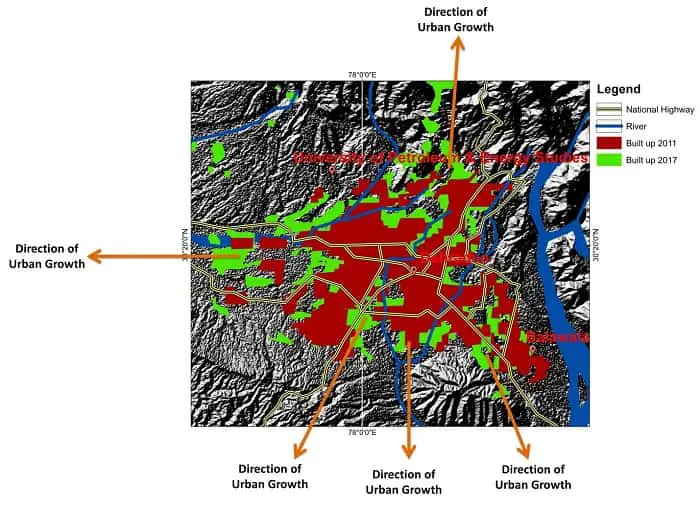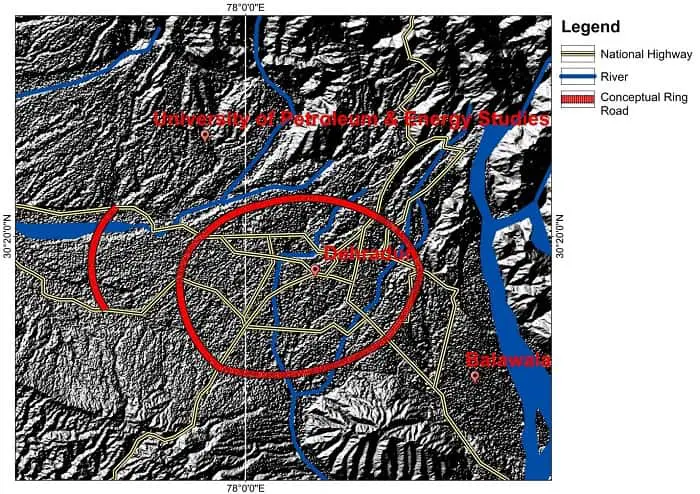Macro-Spatial Assessment of Doon Valley to study the direction of Spatial Growth of Dehradun City
Authors: Kumar Kunal & Anita Mandia (students of B.Planning, School of Planning & Architecture, University of Petroleum & Energy Studies, Dehradun, India)
ABSTRACT:
The macro-spatial patterns of urbanization in India reveal the spatial overlapping of different levels of urbanization with the patterns of axial development, clustering and urban dispersal. The Indian urban scene is a mosaic of the complex and the simple, of the ancient and the recent, juxtaposed on a variable physical landscape of plains, plateaus and hills. Coastal and riverine channels and transport arteries through urban nodes divide and unite these territories. The macro-spatial pattern within Doon valley is unique due to its own physical features that are an attribute to the Himalayan terrain and thus, the cities formed here have a natural character when it comes to the city’s growth or expansion. Especially when it comes to hilly regions, the character of the settlements, its culture & practices heavily depend on the resources available from the environment which is limited by access. One such example is Doon Valley and this paper relays how the Doon Valley has influenced the growth of the city Dehradun because of its dominant physical characteristics with the help of GIS-based mapping.
INTRODUCTION:
Doon valley is situated between 77 degrees 35’ East to 78 degrees 19’ East longitude and 29 degrees 57’ 30”N to 30 degrees 30’30”N latitude and is bounded in the north by Mussoorie-Dhanaulti-Chamba ridge of the Himalaya, in the north east by Chamba-Narendra Nagar ridge, in the north west by river Yamuna, in the east by river Ganga and in the north west to south west by the Shiwalik ridge from near Paonta to Haridwar. Doon valley covers an area of 2130 km2, out of which urban area in 1998 was about 156 km2, which by 2008 has almost doubled. Doon valley with Dehradun as its center is well-connected to the nearby cities within the Doon valley like Mussoorie & Rishikesh.
NATURAL PHYSICAL FACTORS & NATIONAL CORRIDORS AS GROWTH FACTOR:
On the basis of rock and soil types, the valley has been divided into three distinct belts as under:
- The lesser Himalayan belt
- The Doon valley proper
- Shiwalik belt
The Doon valley proper is covered by un-stratified mixed pebbles and boulders with very little matrix. The valley proper is drained to the west of Dehradun town into Yamuna by Asan and to the east into Ganga by Song river. Due to the presence of this natural drainage, water accumulation in this area even during the monsoons is mostly taken care of by the river systems naturally. And because of the drainage of this area, it experienced the expansion of settlements within the areas of these rivers which now is an urban area of Dehradun. The type of soils, river system, and also the climate of Doon valley, which is the typical North Indian subtropical climate and also the presence of the hills in the all-time daily scenery has promoted the growth in settlement pattern.
With the introduction of Dehradun as Uttarakhand State’s capital, National highways to connect the city, to the other States and cities, the pattern of urbanization experienced quite a shift. After this, the future development started to gather along the main corridors of the city and the existing settlement pattern along the rivers started to spread towards these corridors for better opportunities and accessibility of services. Because of the linear nature of the National & State corridors and the rivers, the city of Dehradun has experienced a linear pattern of growth for its urban form and wherever these National urban corridors intersect, they make for the city center due to its engagement with the majority of traffic and thus making it a prime location of service delivery.

Following ‘analysis’ from GIS depicts the difference in the growth pattern between the year 2011 and 2017 which shows how the urban growth has kept expanding along the corridors and the gaps along the rivers have been gradually filled due to the increasing population’s need of land.
RETHINKING THE GROWTH PATTERN OF DEHRADUN CITY:
The city of Dehradun has spatially developed on a linear trail of natural river systems and the man-made national corridors. If we go back to the point where we are in a Dehradun where it has not been much time since the national corridors made their appearance. Dehradun stretches into four different linear directions when we talked about its expansion of urban form. Definitely the problem of accessibility from one end of the linear growth to the other takes a toll on the populous. But at that time, if we were to introduce ‘Ring road’ system to the city, even if it had been just one ring road for the city, the problems, primarily that of traffic congestion that we experience and see in today’s Dehradun might not have been here. In a city, which is built within the mountains covered from all faces of direction, it is crucial to look for the future of the city rather than the present as it not only affects the population but also the natural flora & fauna due to the interaction with new elements such as urban development. When we take a look at this city, we will find out how much unplanned it is. The nature of city’s growth can be termed as spontaneous which was initially not governed by strict rules and regulations or it could be that the law in practice was not well-defined for a city like Dehradun which is located within the Doon Valley. Not often we come across cases like this.

REFERENCES:
Bhandari, Bela, etal. 2016. Change Detection of Land use Land Cover using GIS & Remote Sensing for Doon Valley. SSR International Journal of Civil Engineering. Volume 3 Issue 7. ISSN: 2348 – 8352.
Mishra, Gupta, etal. 2016. Change Detection of Land use Land Cover using GIS & Remote Sensing for Doon Valley. SSR International Journal of Civil Engineering. Volume 3 Issue 7. ISSN: 2348 – 8352.
Kuldeep, Kamlesh. 2011. Land Use / Land cover change detection in Doon valley (Dehradun
Tehsil), Uttarakhand: using GIS& Remote Sensing Technique. International Journal of Geomatics & Geosciences. Volume 2 No 1. ISSN: 0976 – 4380.